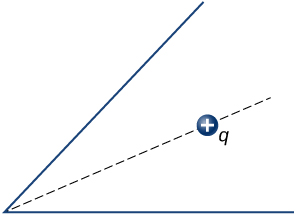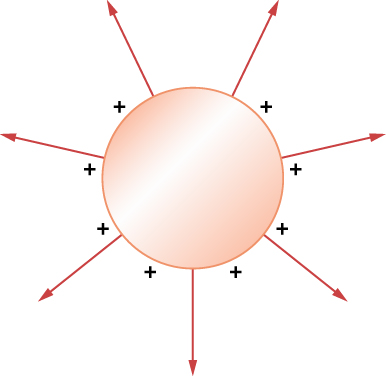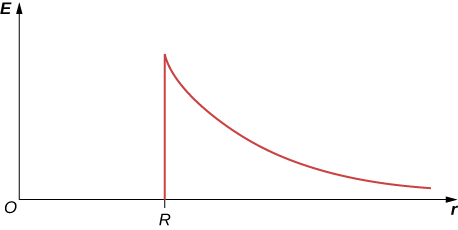| << Chapter < Page | Chapter >> Page > |
A positive point charge is placed at the angle bisector of two uncharged plane conductors that make an angle of See below. Draw the electric field lines.

A long cylinder of copper of radius 3 cm is charged so that it has a uniform charge per unit length on its surface of 3 C/m. (a) Find the electric field inside and outside the cylinder. (b) Draw electric field lines in a plane perpendicular to the rod.
a. Outside:
; Inside
; b.

An aluminum spherical ball of radius 4 cm is charged with of charge. A copper spherical shell of inner radius 6 cm and outer radius 8 cm surrounds it. A total charge of is put on the copper shell. (a) Find the electric field at all points in space, including points inside the aluminum and copper shell when copper shell and aluminum sphere are concentric. (b) Find the electric field at all points in space, including points inside the aluminum and copper shell when the centers of copper shell and aluminum sphere are 1 cm apart.
A long cylinder of aluminum of radius R meters is charged so that it has a uniform charge per unit length on its surface of . (a) Find the electric field inside and outside the cylinder. (b) Plot electric field as a function of distance from the center of the rod.
a.
E inside equals 0; b.

At the surface of any conductor in electrostatic equilibrium, Show that this equation is consistent with the fact that at the surface of a spherical conductor.
Two parallel plates 10 cm on a side are given equal and opposite charges of magnitude The plates are 1.5 mm apart. What is the electric field at the center of the region between the plates?
Two parallel conducting plates, each of cross-sectional area , are 2.0 cm apart and uncharged. If electrons are transferred from one plate to the other, what are (a) the charge density on each plate? (b) The electric field between the plates?
The surface charge density on a long straight metallic pipe is . What is the electric field outside and inside the pipe? Assume the pipe has a diameter of 2 a .

, inside since
A point charge is placed at the center of a spherical conducting shell of inner radius 3.5 cm and outer radius 4.0 cm. The electric field just above the surface of the conductor is directed radially outward and has magnitude 8.0 N/C. (a) What is the charge density on the inner surface of the shell? (b) What is the charge density on the outer surface of the shell? (c) What is the net charge on the conductor?
A solid cylindrical conductor of radius a is surrounded by a concentric cylindrical shell of inner radius b . The solid cylinder and the shell carry charges + Q and – Q , respectively. Assuming that the length L of both conductors is much greater than a or b , determine the electric field as a function of r , the distance from the common central axis of the cylinders, for (a) (b) and (c)
a. ; b. ; c. since r would be either inside the second shell or if outside then q enclosed equals 0.

Notification Switch
Would you like to follow the 'University physics volume 2' conversation and receive update notifications?